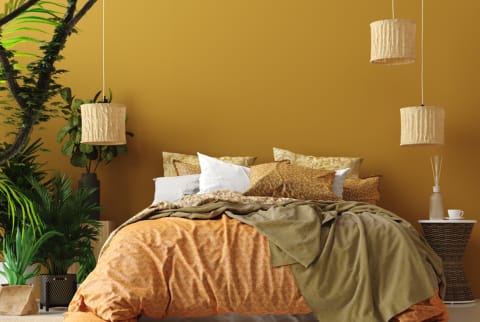Advertisement
Design Experts On The Best Colors For The Bedroom + How To Use Them


The right bedroom decor can set the stage for restful sleep and uplifting mornings. Since this is typically the last room you see before drifting off at night and the first you see when you wake up, you want to be intentional about what you bring into it and what you leave out.
According to the field of color therapy1, colors should play an important role in bedroom decor as they can affect our emotions and mood states. "We interact with color constantly—knowingly and unknowingly. It's such a beautiful, powerful tool that we all have that we kind of forget about and take for granted," color therapist Walaa AlMuhaiteeb tells mindbodygreen.
Here, color and design experts name their favorite sleep shades and share ideas on how to splash them around the bedroom for maximum rest and relaxation.
First, consider what you want to get out of your space.
Before making any big decisions about your bedroom's color story, IKEA U.S. interior design manager Barry Reidy says you'll want to get clear on your goals for the space.
"Firstly, I would recommend asking yourself, what is the atmosphere and mood you want to create?... What does a soothing space mean for you?" Reidy tells mbg. "A bedroom can be your superpower. We all need a space to relax in, to feel comfortable and safe in, and recharge."
Interior designer Lisa Galano adds that with so much going on in our day-to-day lives, bedrooms can serve as havens to help us slow down and reflect. Think about how your current space does or does not promote quiet moments of contemplation.
Narrow in on a relaxing tone that speaks to you.
Seeing as many of us want our bedrooms to help us calm down, filling them with bright, stimulating colors will be counterintuitive. "If we put in colors that are exciting and stimulate the mind—such as yellow, for example—it won't give us restful sleep. It won't really help the goal of the space," says AlMuhaiteeb.
Instead, here's a list of more nurturing shades that Reidy, Galano, and AlMuhaiteeb associate with a calming sleep space:
- Light blue
- Light gray
- Light pink
- Mauve
- Natural wood tones
- Off-white
- Peach
- Soft green
- Teal
- Warm beige
These light, more muted shades tend to be easy on the eyes and less stimulating to the senses than bright, loud colors. As such, most people will find them relaxing to look at.
However, the experts agree that color choice is personal, so you have to take your own preferences into account too. For example, AlMuhaiteeb notes that while soft blues and teal shades are often recommended for bedrooms, someone who has negative associations of water or waves might find them off-putting. To get some clarity on which tones speak to you, she recommends considering the goals you set for your space and how you want it to make you feel, then closing your eyes and seeing if any colors come to mind. Those are the shades you'll want to start with.
Introduce complementary colors with your bedding, window treatments, and art.
Of course, your bedroom doesn't need to be just one color. Once you land on a main shade or two, you can bring in pops of other complementary tones throughout the room. Again, consider your goals for the space: If you get dressed in your bedroom every morning and want to feel energized as you do, consider adding small pops of brighter colors to that area. "It's really about balance and a combination of colors," says AlMuhaiteeb.
As for what other parts of the bedroom can usually handle some more color, Reidy is a fan of layering different shades on the bed. "Your textile choice can transform your existing space and make it feel brand-new. It's the quickest way to add color or simply change it up for the season," he says. Think thicker, chunkier blankets in warmer tones in winter that can give way to lighter bedding once spring hits. "Your pillows and throws can add color and pattern. It's important to think about how each element of your interior comes together to create the look you want. It's like a great outfit."
And don't underestimate the power of the right window treatments, he adds. "You can choose to make a statement or simply have them blend with your wall color. Layering your window treatment will also improve the functionality." For example, he says you can start with dark blackout blinds to promote sleep. From there, layer with a sheer curtain to let in soft, dappled sunlight during the day, and introduce more color with your top curtain. "Just change out this top layer to introduce a new color," Reidy says. "Small change, big impact."
Beyond curtains and bedding, Galano loves to introduce new colors into the bedroom using art prints. Strategically placing your lighting to hit these bedroom works can help make their tones really shine.
The bottom line.
Soft, muted colors are typically considered great picks for the bedroom. However, you want to give some thought to your own color preferences and goals before choosing colors for your sleep space. Pair your palette with a supportive mattress and pillow, adaptable light fixtures, and low-tech nightstand fixings for a bedroom that colors you relaxed night after night.
